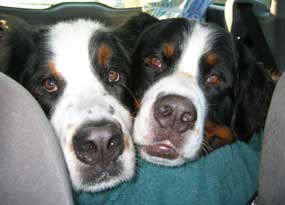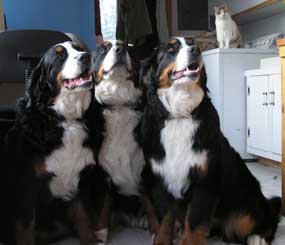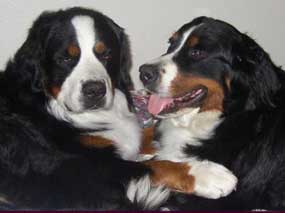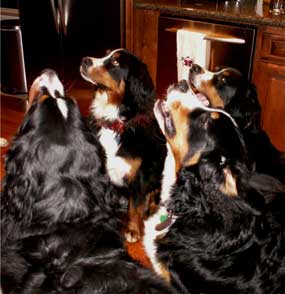Living in Harmony with Dogs
Ruth Reynolds
October 21, 2008
Originally published in The BMDCA's Newsletter, 'The Alpenhorn', December, 2008.
 How we avoid confrontations between dogs in the multi-dog household and in the household whose population is changing on an irregular basis varies from home to home. Peacekeeping techniques are abundant and as different between successfully peaceful households as are their inhabitants. For some dog managers it seems to come effortlessly. However, as most breeders and others who live with and manage a larger group of dogs can attest, pinpointing the specific details of peacekeeping management requires a great deal of thought. This becomes apparent when we prepare to leave our dogs in another's care, or worse, leave them in another's care without preparation.
How we avoid confrontations between dogs in the multi-dog household and in the household whose population is changing on an irregular basis varies from home to home. Peacekeeping techniques are abundant and as different between successfully peaceful households as are their inhabitants. For some dog managers it seems to come effortlessly. However, as most breeders and others who live with and manage a larger group of dogs can attest, pinpointing the specific details of peacekeeping management requires a great deal of thought. This becomes apparent when we prepare to leave our dogs in another's care, or worse, leave them in another's care without preparation.
Understanding some basic principles of pack management may help identify what is necessary to achieve peace in the family with multiple dogs. Recognizing what we do already that achieves the results we want gives us the option to do more of it intentionally. Recognizing what we do or don't do that produces undesirable results gives us the option to change that intentionally as well.
Sound like a lot of work? It's not really. It requires some thought however. First comes thinking about the learning opportunities our dogs have in daily life with us. Second comes identifying and selecting specific events in our daily actions that create opportunities for our dogs to behave in a way we prefer. Part of that process includes identifying what kind of reward an individual dog needs to set a specific response as their everyday chosen behavior because it produced the result THEY want. And, third but not least, is applying thought to identifying these opportunities which are abundant already in the course of our daily lives. Meeting each animal's need to serve us is what it takes to live with ease in a peaceful household with dogs.
 STYLES OF PACK MANAGEMENT
STYLES OF PACK MANAGEMENT
Always present in the peaceful household is a human's intolerance for aggression.
In addition one of these is present as well:
A) adequate preventive training using methods incorporating mutual respect
B) isolation of disagreeing individuals from one another
In dog pack ownership, one can manage dogs via the A style or the B style. The latter is very difficult in a household situation and more easily achieved in a kennel situation. Means of isolation in a non-kennel situation include cordoning off areas of the home as inaccessible to individuals and thus creating intense boundary lines for pack members to argue over or respect. Often developing in the individual dog the respect for the boundaries requires as much training as developing respect without the boundaries. However, the physical barriers used seem to give some owners a sense of ease in their daily routine.
There are households in which a particular dog is removed to a place of safety such as a crate inside or kennel outside when no human supervision is present due to the animal's propensity to get into trouble when left to its own devices. In another home all the dogs run loose together in the home when the owner is away. The dog who must be crated to keep out of trouble is a higher training maintenance dog than the owner either realizes or is willing to train to make it a reliable dog.
How to Get Started
-
- 1. Respect
A home in which the inhabitants respect one another and practice mutual respect is a peaceful home. Given the opportunity to serve us in a respectful manner and to be rewarded in a way meaningful to them, most recalcitrant dogs' behavior is observably improved. - 2. Training occurs inadvertently
 Training comes in many forms and is often reciprocal between dogs and the people they manage. Most training occurs inadvertently and without intent on our parts. Our dogs learn most of what they know simply through experience with results. If going away from the dinner table and laying down gets a better result than sitting at the table and begging, the dog soon learns to go lay down. The well trained human, stepping over the sleeping dog assures the dog's success as a trainer of humans and its elevated position in the hierarchy as well. Repetitions with positive results build consistency.
Training comes in many forms and is often reciprocal between dogs and the people they manage. Most training occurs inadvertently and without intent on our parts. Our dogs learn most of what they know simply through experience with results. If going away from the dinner table and laying down gets a better result than sitting at the table and begging, the dog soon learns to go lay down. The well trained human, stepping over the sleeping dog assures the dog's success as a trainer of humans and its elevated position in the hierarchy as well. Repetitions with positive results build consistency.
Keys to successful pack management with ease lay in A) identifying opportunities for our dogs to respond to all interactions in an acceptable way B) our rewarding them for their desired behavior. - 3. Focus on one at a time
Isolating each animal for some one on one daily interaction with you is a place to start. Teaching simple commands like sit, down, stay, come, wait (at all doorways), and any tricks you might want to incorporate like shaking paws, wait to get the treat off the floor, find the hidden treat or others, gives your dog the skills he will need to serve you. - 4. Use very short training opportunities
If you spend no time each day working with your dog, and he receives no intentional consistent positive reinforcement, it's easy to start a new training regime. If you'll interact with your dog for 3 seconds three times a day, you've increased his training and serving opportunities tremendously. Have him wait, sit or speak on command 10 times a day and you've increased his training opportunities ten times. It is likely more effective for you to LIVE IN TRAINING WITH your dog than for you to give him ten minutes of rote exercises daily. - 5. Essential respect-building skills to teach
· Always have your dog wait at doorways, letting you pass through first.
· Always have your dog wait to dive into his dinner until you give him an okay to proceed
· Ask your dog to turn his attention to you 10 times a day and praise him softly and quickly for doing so.
· Have your dog "watch me" for 3 seconds before praising and releasing verbally. increase over time to ten seconds.
- 1. Respect
It's Rarely Hopeless
 It often takes a series of altercations between dogs or dogs and people for an owner to realize action must be taken before someone is hurt seriously. When a dog behaviorist or trainer is called in for consultation and reveals there's not a magic cure to alleviate the problem, owners make choices on the changes they will make. Sometimes dogs are rehomed. Sometimes training ensues. Sometimes changes come too late and dogs or people are victimized.
It often takes a series of altercations between dogs or dogs and people for an owner to realize action must be taken before someone is hurt seriously. When a dog behaviorist or trainer is called in for consultation and reveals there's not a magic cure to alleviate the problem, owners make choices on the changes they will make. Sometimes dogs are rehomed. Sometimes training ensues. Sometimes changes come too late and dogs or people are victimized.
If you're midst a near crisis situation at this point and isolation has become a way of life for your dog(s), it is probably a good idea to seek some professional help. Another set of eyes can likely see things you're inadvertently doing that encourage the behavior you want to discourage. While you're lining up some professional help, start working with each dog individually for a few moments several times a day. Begin with the most challenging dog. This one needs the most work today and probably always. Exercises that require self restraint are the best. After all you're seeking to develop self discipline in your canine family members so everyone in your household can live in harmony through mutual respect.
Sound too simple? Try it. Dogs LOVE to work for us. Rewarding them for a sit, wait, down with a food reward or a kind, "thank you," builds their desire to repeat the desired behavior. Building on this foundation over time creates a relationship between owner and dog many owners of problem dogs cannot imagine achieving.